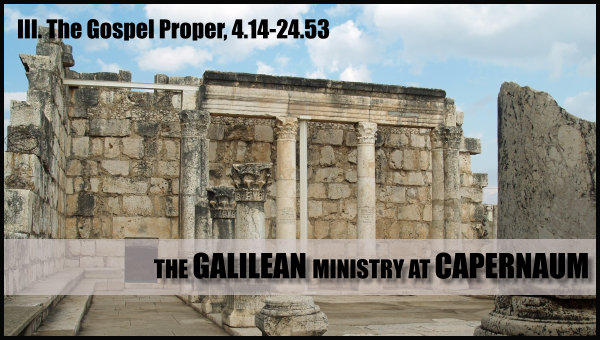By Tyson Thorne

The Galilean Ministry at Capernaum & Synagogues of Lower Galilee, 4.31-44
Jesus left Nazareth and continued his journey to Capernaum. Only one week after his near death experience in his home town, we find Jesus teaching once more in a local synagogue. Once more the people were amazed with the sermon, but on this occasion they were more impressed with his style than with the content. We don’t know what passage Jesus taught from, it may have been the same as in Nazareth or it may have been something entirely different. Luke didn’t see fit to provide the details.
Regardless, at the conclusion of the teaching portion of the service a man comes forward ranting and raving. He is speaking in another “voice”, one not his own, and he has knowledge he should not have all indicating demonic possession. The knowledge he has is that Jesus is indeed God, something he announces loudly. Two things happen next: Jesus orders the demon to be silent, then orders him to come out. The possessed man is unharmed and instantly healed, which if you know anything about Jesus’ healings is not surprising.
What is surprising is Jesus’ response to the demon revealing his identity. The most common explanation is that Jesus did not want his identity revealed, but why? Jesus had already admitted to his childhood friends and neighbors that he was the Messiah, so what difference would it make if the demon affirmed this truth now? There is no clear answer, but my inkling is that Jesus’ mission is to develop people’s faith not to offer definitive proof of his true nature. The Messianic signs (miracles) he performed should be enough to convince humanity, not the testimony of unclean spirits.
Some people are troubled by Jesus’ command to the demons, and to others that he instructed to keep quiet about his healing them and later, even informing the disciples to tell no one he was the Messiah. These should not trouble any, however, as the answer is easy to discern. In the case of demons, no one should trust what they say anyway. In the case of those he healed, he didn’t need more crowds needing healing when his primary mission was to teach. Just a few verses later in this same passage we see that when Jesus sought solitude to commune with the father the crowds found him and asked him to stay. Jesus leaves them giving this reason:
“I must proclaim the good news of the Kingdom of God to the other towns too, for that is what I was sent to do.”
In the case of the disciples, the timing to announce Jesus’s identity had not yet come. Jesus lifted the ban after the resurrection, that is after he had already secured salvation for humanity.
Following this event Jesus goes to Simon’s home and there finds the lady of the house struck down with a debilitating illness. Once again we see Jesus commanding – this time an illness rather than a demon – her back to full health. This should come as no surprise to those who know that Jesus spoke the universe into existence. He is the Word. She was completely healed, got up and served them. Imagine her relief! Once word got out, the entire city started bringing their sick and possessed to Jesus, and he healed them all. As with the first demon Jesus encountered, the others also expressed surprise at Jesus’ presence. Their attempt to identify him resulted in the same sentence, a command to silence and an instant exorcism.
After what must have been a draining evening, Jesus sought some alone time with the Father. Even in the wilderness, however, the crowds found him. He departed then for Lake Gennesaret.
|
|